Case Study
Seismic
Assessment of the Mustafa Inan Viaduct
- Seismic re-assessment study following earthquake damage
- Linear and nonlinear dynamic analysis using 3D thick beam elements
- Very good correlation achieved between previously measured and
calculated modal frequencies
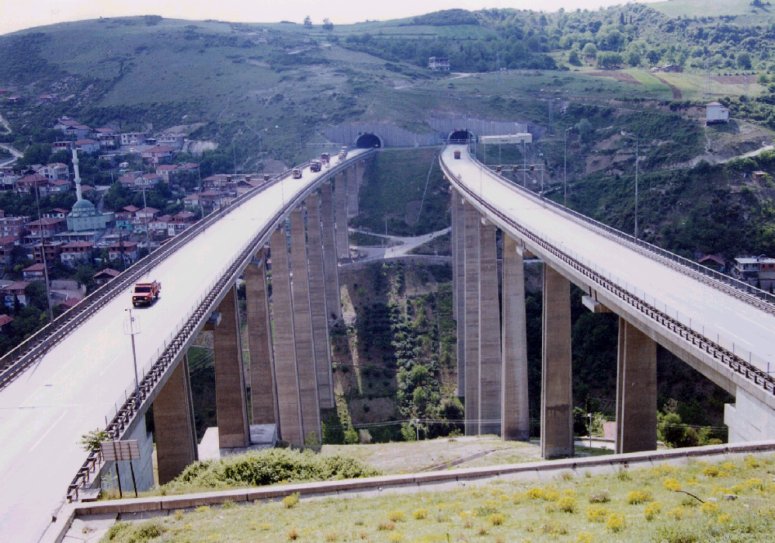
In August 1999, the Kocaeli earthquake in Turkey damaged a number
of structures on the Trans-European Motorway. In all, 20 viaducts, 5 tunnels, and a number
of overpasses were affected. Damage varied from concrete spalling, shifting of girders
from their seats, pier tilting, approach fill settlement, and for some structures total
deck collapse. Gebze Institute of Technology, with the permission of and in cooperation
with the Turkish general Directorate of Highways, have used LUSAS Bridge to study
the effects of the earthquake on a number of the structures including a seismic assessment
study of the Mustafa Inan viaduct - located just 5km from the epicentre.
Overview
The Mustafa Inan viaduct consists of two carriageways - both of 10
equally spaced, 40m long, cell box girders resting on elastomeric bearings and simply
supported on what, at the time of its construction in 1982, where the tallest piers ever
built, at 90m in height. Seismic buffer stops restrain the girders. Because of the great
variation in lateral stiffness of the piers the bridge exhibits a complex dynamic
behaviour. Apart from damage to the seismic buffers located at the second longest pier in
the central span the viaduct appears to be structurally intact following the earthquake.
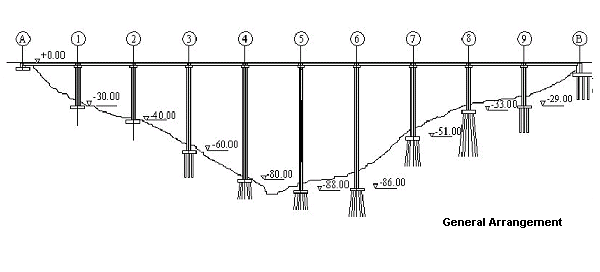
Modelling
Ambient vibration test data obtained from sensors before the earthquake
hit helped to derive the dynamic characteristics of the undamaged structure and assisted
in the calibration of the LUSAS model. 3D thick beam elements were used to represent the
girders and piers. Whilst girders were simply supported between the piers, they were
modelled as being continuous to simplify the model. In order to investigate the influence
of out-of-phase movements on potential pull-off and drop collapse effects, the elastomeric
bearings were modelled as linear spring elements with appropriate end constraints. For
nonlinear modelling, 3D co-rotational, thick-beam elements were used. This type of element
allows assignment of elastic perfectly plastic material characteristics and a solution
procedure taking into account large geometrical deformations. An implicit method with the
Hilber-Hughes-Taylor integration scheme with a time step of 0.025 sec was chosen because
it is unconditionally stable. Input acceleration data for a site just 2 km south of the
viaduct was used in the analyses.
Results
Modal shapes and corresponding frequencies were found to be very
sensitive to the variation in spring stiffness of the pier-to-deck connection.
Participation factors, calculated by LUSAS, indicated that the lower-frequency modes (0.4
- 1.0 Hz) contributed 90% of the overall response of the structure. Comparison of results
from linear and nonlinear transient dynamic analyses indicated that the shorter piers are
more likely to sustain larger moments and shear forces than the longer mid-piers. In
addition, inspection of the deformed shape of the viaduct in the time domain revealed
considerable snap-through behaviour in the longer piers at middle spans, leading to
amplified second-order effects. As a result, geometric nonlinearity must be taken into
consideration for a more accurate representation of the real behaviour.
By using LUSAS Bridge very good correlation
was achieved between the calculated and measured modal frequencies. The research study
indicated that the viaduct exhibits three different dynamic behaviours in three different
frequency bands.
- In the first (low) frequency range of 0.4- 1Hz, relatively large
displacements are of major concern and the structure appears to be very sensitive to
displacements. The structure is subjected to proportional damping in lower modes since the
piers exhibit in-phase motion. The calculated participation factors indicate that the
first three modes contribute about 90% of the structure. Thus, the out-of-phase motion in
higher modes (above 1Hz) were ignored, and a Rayleigh-type proportional damping was
assumed. Results of the spectral analysis indicated excessive shear forces in the piers
close to the supports.
|
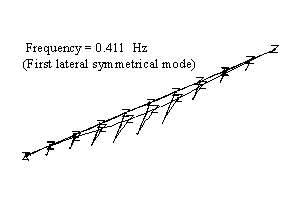
|
- The second frequency range of between
1.0 and 2Hz, corresponds to the higher longitudinal and transverse modes. Displacements
near the dominant frequency of the structure decreased toward the supports, and a
substantial amount of energy was shifted to the frequency range 1–1.5 Hz. This was
due to the response of the side frame at 1.5 Hz and to other high-frequency effects -
confirming that the structure is more sensitive to velocity than to displacement. At
frequencies between 1.2 and 1.5 Hz pull-off and drop-collapse effects could occur due to
out-of-phase motion of the side and central frames. This critical range may be important
for the response of the structure in future earthquakes, where short duration and high
acceleration may dominate.
|
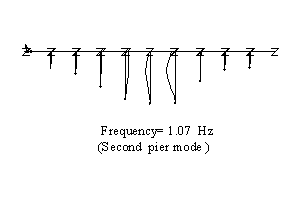
|
- The third frequency range lies above 3 Hz, and includes the response of
the floating structure sitting on its elastomeric bearings at 3.7 Hz.
The out-of-phase motion of the side and central frames was identified in
both the experimental and numerical studies. The nonlinear analyses showed that the
earthquake would cause an expansion in the deck containing the expansion joint, indicating
a possible drop-collapse behaviour or a contraction of the symmetrical side, indicating a
possible failure of the seismic buffer stops. This was confirmed by the preliminary damage
reports of the viaduct.
There is a reported 70% chance of another major
earthquake within 30 years in the region so results from dynamic tests and finite element
analysis studies are necessary to adequately model the behaviour of these structures and
to help enhance the earthquake resistant design codes used for these kinds of highway
bridges.
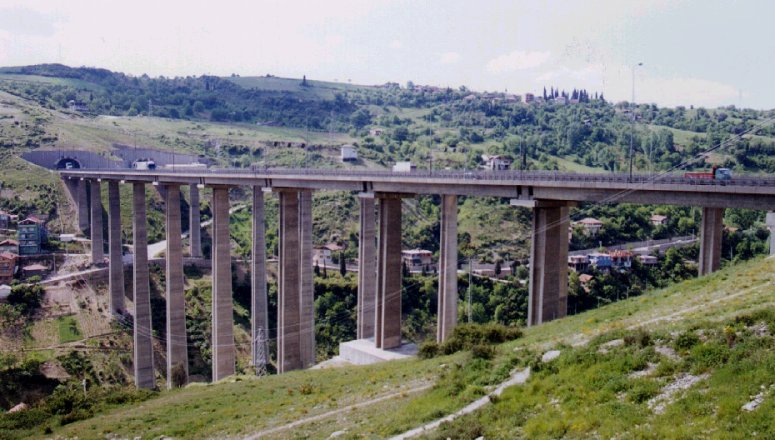
Gebze Institute of Technology gratefully acknowledge the logistical and
technical support provided by the Turkish Highways 1st Division and Kandilli Observatory
Earthquake Research Institute in their research work which will be extended to other
essential highway structures located in the region to improve design and analytical
techniques, to identify structural damage, and to make decisions on structural
strengthening needs.
Find out more
Other LUSAS Bridge case studies:
|
|
Software Information
|